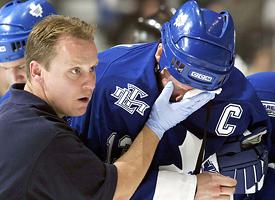This is part of our Hockey 101 Series
There are 12 sticks on the ice at a time during the majority of an NHL game. Each one is wielded by a professional athlete.
The NHL has determined that each professional is responsible for controlling his stick at all times. High sticking is the penalty that is assessed when one player loses control and makes contact with an opponent above the shoulders.

High Sticking, the Penalty
When the stick comes into contact with another player, above the shoulders, a penalty can be called. These incidents occur most often during scrums along the boards and can be the result of a player simply turning his body too quickly to keep control of his stick. Another common event is when a defender swings his stick towards the puck, but his stick collides with the other players. The defenseman’s stick then travels up the opponent’s and slides all the way up to the facial area.
Normally, this is just a minor penalty. But in every single case, the referee’s check for signs of injury. A double minor is assessed if the referees find blood. A true testament to the old hockey proverb: “no blood, no foul.”
High Sticking, the Infraction
Along with goals scored by a distinct kicking motion, a goal scored by a stick held above the shoulders will be disallowed. No penalty is assessed for high sticks of this type, but the crushing feeling of seeing the puck in your opponent’s net but not earning a point is punishment enough. If a puck is played with a high stick and no other player is in danger of being hit by the high sticking, play is stopped. The ensuing faceoff moves backwards (against the team that committed the infraction).